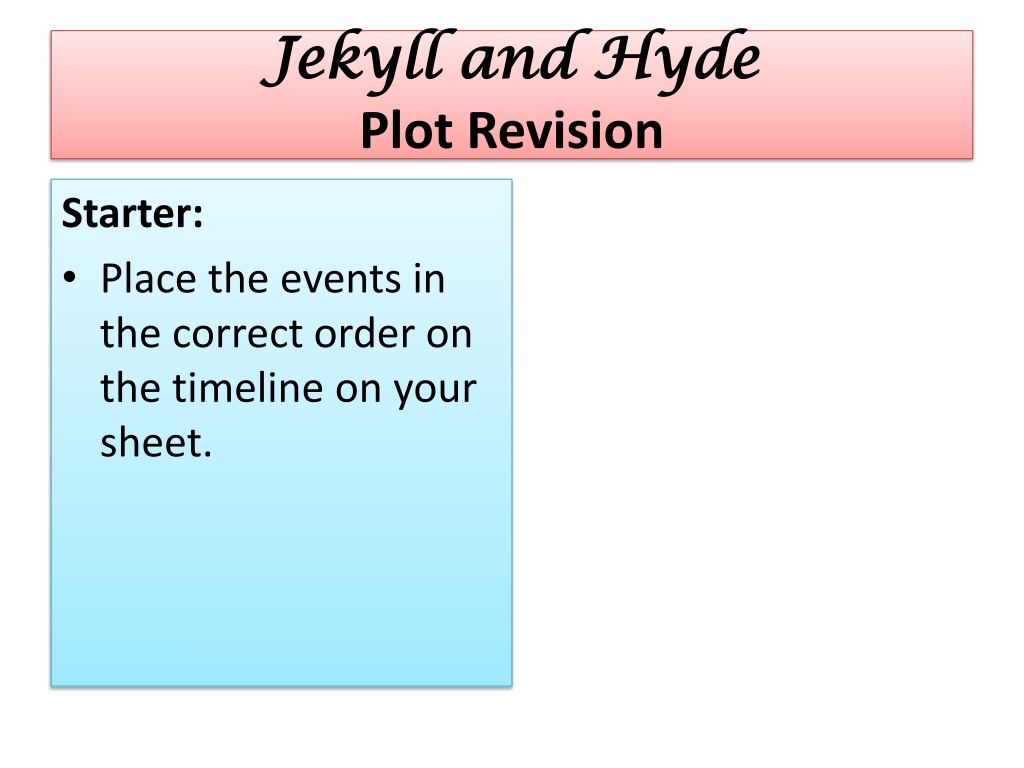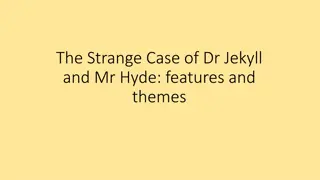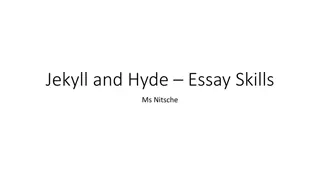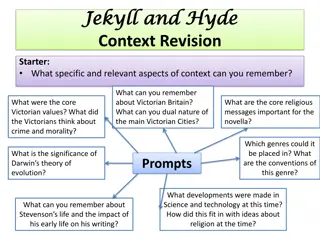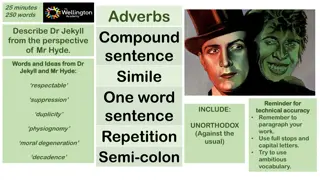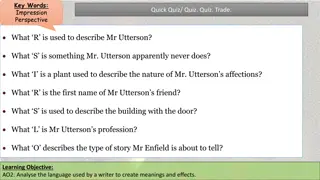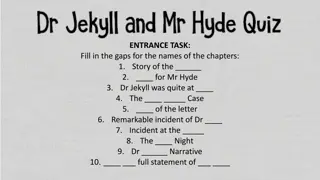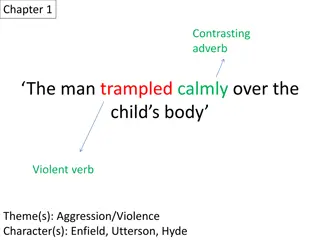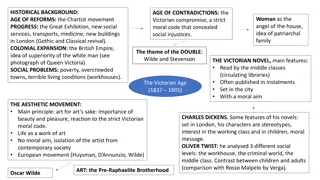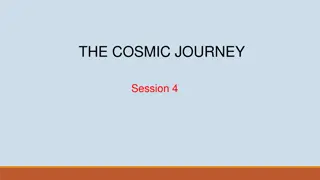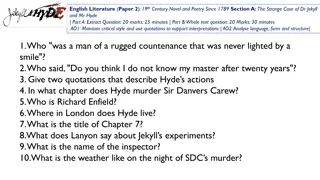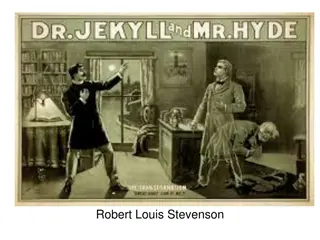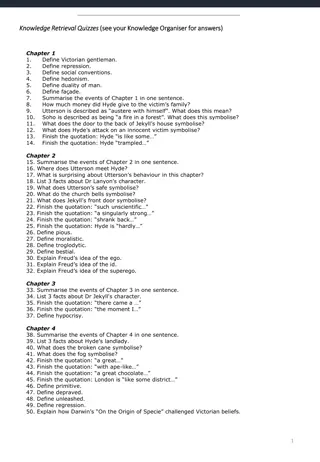Analyzing Key Events in Jekyll and Hyde
Stevenson's "Strange Case of Dr. Jekyll and Mr. Hyde" unfolds through a captivating narrative that delves into the duality of human nature. Starting with the mysterious Mr. Hyde and the respectable Mr. Utterson, the plot twists through murders, transformations, and the unraveling of dark secrets. The significance of each chapter adds layers to the story, exploring themes of identity, reputation, and morality in Victorian London.
Uploaded on Sep 27, 2024 | 0 Views
Download Presentation

Please find below an Image/Link to download the presentation.
The content on the website is provided AS IS for your information and personal use only. It may not be sold, licensed, or shared on other websites without obtaining consent from the author.If you encounter any issues during the download, it is possible that the publisher has removed the file from their server.
You are allowed to download the files provided on this website for personal or commercial use, subject to the condition that they are used lawfully. All files are the property of their respective owners.
The content on the website is provided AS IS for your information and personal use only. It may not be sold, licensed, or shared on other websites without obtaining consent from the author.
E N D
Presentation Transcript
Jekyll and Hyde Jekyll and Hyde Plot Revision Starter: Place the events in the correct order on the timeline on your sheet.
The plot: What happens in the text? Place the events below in the correct order onto the timeline on the right. a. Hyde goes to Lanyon for help. b. A maid witness Hyde killing Sir Danvers Carew. c. Enfield sees Hyde trample over a young girl. d. Mr Guest notices the similarity between Jekyll and Hyde s handwriting. e. Enfield tells Utterson the story of the door. f. Utterson and Poole break into Jekyll s cabinet. g. Dr Lanyon dies of shock. h. Utterson reads Jekyll s full account of the case. i. Jekyll refuses to change his will. j. Utterson tracks down Hyde. h. Utterson and Poole find Hyde dead. i. Enfield and Utterson see Jekyll at his window, looking miserable. j. Jekyll becomes sociable again. k. Jekyll transforms into Hyde without using the potion.
Plot Recap https://www.youtube.com/watch?v=feI3MT0zuO c As you watch, make notes on the key plot moments. We will discuss the significance of each chapter afterwards.
TASK: Exploring Key events I am going to go through with you the various aspects of each chapter. You should make notes on the significance of each chapter as we go through. When we have finished, you need to complete the second column and need to identify key quotations and explore one killer quotation. HINT: Use your PLCs!
Significance of Chapter 1 The Story of the Door Stevenson begins the novel by introducing the reading to Utterson, a serious man with respectable qualities and strong values. Stevenson uses a third person narrator for chapters 1-8. He incorporates however, a testimony of Enfield, Utterson s kinsman who witnesses a man (who the reader later knows to be Hyde) trampling over a young girl. The use of this narrative feature adds to the sense of mystery as, from the outset, Hyde is portrayed as an evil but mysterious character. The instant dislike also links to physiology. The apprehension of the man and the significance of the cheque add in further intrigue as there is an acknowledgment of a link with a yet to be named Jekyll. Hyde s door and the sinister building in which he enters, establish a sense of duality in the setting and sinister nature of parts of London. Further intrigue and links to Victorian respectability and reputation are apparent in the decision not to mention the even again.
Significance of Chapter 2 Search for Mr Hyde Utterson, perhaps mirroring the Victorian readers, is deeply troubled and disturbed by the prospect of Hyde. The motif of letters and documentation is first introduced with the inclusion of Jekyll s will, increasing Utterson s suspicion at the terms of the will. Utterson seeks Hyde and like many others is troubled by the physical appearance of Hyde, perhaps linking to the idea that he is evil personified. The idea of the detective genre is apparent here as Utterson takes on the role. The ideas of respectability and reputation are also important as Utterson assumes that Jekyll must be being blackmailed. This subtly hints at what was perceived as immoral acts in Victorian society such as homosexuality. The character of Lanyon is introduced as another juxtaposition to Jekyll. Highly respected, Stevenson uses a plethora of positive adjectives to ensure that readers are positioned to see that he is good. He dismisses Jekyll s science as unscientific balderdash.
Significance of Chapter 3 Dr Jekyll was quite at ease The reader finally meets the protagonist of the novella, Dr Jekyll. His physical qualities are described and differ greatly from Hyde. This is important as he is initially depicted as someone, as the title suggests, quite at ease at the situation with Hyde whom he could be rid of if he chose to be. This is a significant plot point as this hubristic error will prove to be his undoing. Jekyll is portrayed as having an ambiguous interest in Hyde in this chapter, adding to the sense of mystery as to what connects the characters.
Significance of Chapter 4 The Carew Murder The perspective is again skewed in chapter 4 with the introduction of the maid, who witnesses the vicious murder of Carew. Carew is portrayed to juxtapose Hyde. He is described pleasantly with use of the colour white, which in literature suggests innocence. Again, Stevenson cleverly weaves Utterson into the story with the use of a letter addressed to him on the body of Carew. (It is often referred to as an epistolary novel a novel written as a series of letters, diaries or other documents - for the inclusion of this type of feature, also Lanyon s narrative, Jekyll s confession) When Utterson goes with the police to Hyde s lodgings, Stevenson again makes a point of linking Hyde with unsavoury London. His rooms have been ransacked and further connections are made with Jekyll. Physiognomy again is hinted at as although those who have met Hyde all describe him as abnormal, their experiences all differ in some way, thus adding to the mysterious nature of the text.
Significance of chapter 5 Utterson, further acknowledging the link between Jekyll and Hyde, visits a troubled Jekyll. Stevenson presents Jekyll here as ill and scared. The importance of letters is picked up again in this chapter as Jekyll gives Utterson a letter supposedly from Hyde, indicating a break from him. Stevenson adds to the sense of mystery by Utterson suspiciously clarifying whether or not a messenger has been they have not; Utterson then adds to this by showing the letter to Mr Guest. This incorporates another Victorian fascination graphology, the study of handwriting. It is clear that there is a connection between the handwriting of the note and a later note from Jekyll. Interestingly, the ever loyal Utterson is troubled by the notion that his friend should forge for a murderer.
Significance of Chapter 6 The plot is initially moved forward with the idea that Hyde is never heard of again. Tension is initially reduced as Jekyll becomes his former self again at the start of this chapter. This is a technique often employed by writers to lull the reader into a false sense of security. This is rapidly brought to an end however, by the sudden refusal of Jekyll to see Utterson. The symbolism of the door is again important as the barriers to the truth are fully in force. When Utterson then visits Lanyon, he is markedly changed and terribly ill. He admits to a shock, and as he will not speak of Jekyll, we are led to see the link between them, but Stevenson cleverly does not reveal the truth at this point, adding suspense and we move towards the climax. With Lanyon s death comes another letter. Ironically, if Utterson had not been a character so consumed with doing the correct thing, thus Stevenson is perhaps hinting at the ridiculous nature of Victorian propriety.
Significance of Chapter 7 In a structural link back to chapter 1, Utterson is depicted on his usual walk with Enfield at the start of chapter 7. Significantly however, Enfield now notes the physical link between the door mentioned previously and Jekyll s house. The weather is important in this chapter as it provides a sense of eerie foreboding. Jekyll is visible at the window, like a disconsolate prisoner and the men have polite conversation until suddenly Jekyll is struck by a look of abject terror and despair . The shutting of the window is perhaps significant as windows are transparent. Thus although an attempt is made to shut out the truth, the two men leave appealing to God s help suggesting that they may now know the truth .
Significance of chapter 8 The Last Night This chapter is the structural climax of the novella. Again the pathetic fallacy is used in the dark descriptions at the opening to the chapter to pre-empt the negative climax. Tension is built throughout the chapter: the unseasonable weather, the irregularity in behaviour of the servants, the mystery of who is in the room, culminating in the breaking down of the door. Religion is also significant in this chapter. Hyde is condemned as a self-destroyer, a sinful death, and Jekyll s religious books are annotated with blasphemous scribblings, thus firmly establishing Hyde and Jekyll to be almost heretic. Although this is the end of the story the resolution happens with the full disclosure of what has happened to Jekyll in Lanyon s narrative and Jekyll s statement of the case.
Significance of Chapter 9 Lanyons Narrative Stevenson changes the nature of the novel at this point. Stevenson moves the plot back in time (analepsis) and it has shifted to a first person narrative written from Lanyon s perspective. Lanyon recalls the events of the fateful evening. He explains how he received a letter (another one!) from Jekyll and the text of this letter is included in the narrative. Despite their differences, the nature of Victorian friendship meant that he would still be willing to help Jekyll in an emergency. The detailed nature of the instructions perhaps represent the scientific nature of the two men. He relays the details of the evening but importantly, Stevenson does not include the rationale about Jekyll s behaviour at this point, leading up to a final reveal in the final chapter of the novel.
Significance of Chapter 10 Henry Jekyll s Full Statement of the case Another first person narrative completes the novel. Jekyll describes his privileged upbringing and explains how his wish to maintain respectability led him to live a double life. The significance of duality in the text is brought to understanding as he explains that he believes that men have two aspects to their lives: one controlled and moral, the other instinctual and corrupt. This allows the reader to trace back through the presentation of Jekyll and Hyde in the text to see the two qualities. The reference and importance of scientific development, but also its limitations are also signified here when Jekyll is explained to have developed a potion to change into Hyde when he chose. However, as it becomes clear, by the events of chapter 6 and 7 he transforms involuntarily. Perhaps this is due to the darker side of his personality becoming ever more powerful and monstrous following the murder of Carew. Significantly, this chapter reads as a final confession. He has run out of the original drug and won t be able to change back to Jekyll.
Significance of chapter Key Quotations Analysis of Killer Quotation Ch. 1 Ch. 2 Ch. 3 Ch. 4 Ch. 5
Significance of chapter Key Quotations Analysis of Killer Quotation Ch. 6 Ch. 7 Ch. 8 Ch. 9 Ch. 10
